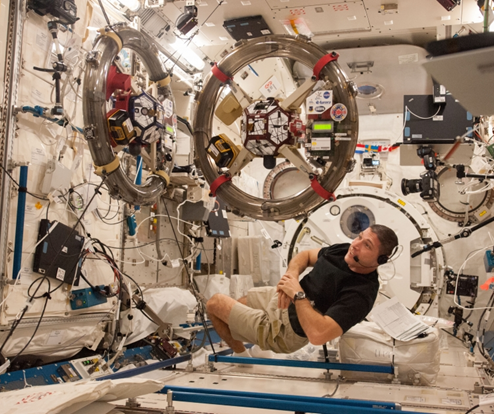Sponsors: Defense Advanced Research Projects Agency (DARPA)
National Aeronautics and Space Administration (NASA)
Collaborators: David Miller (Co-I), Peter Fisher, Alex Buck, Greg Eslinger (MIT)
John Merk (Co-I), Roedolph Opperman (Aurora Flight Sciences)
Elisenda Bou (UPC Barcelona Tech)
RINGS (Resonant Inductive Near-field Generation System) is a demonstration of combined technology for electromagnetic formation flight (EMFF) and wireless power transfer (WPT) that will launch to the International Space Station (ISS) in July 2013. Currently, multi-satellite constellations use traditional thrusters to maneuver into a desired position and orientation relative to each other which shortens the operational lifetime of the constellation due the limited onboard propellant. Electromagnetic formation flight is a propellant-less propulsion technology that aims to mitigate this operational lifetime constraint. Magnetic forces and torques are generated by circulating electrical current through a coil attached to each vehicle which can be used to reorient the satellites relative to one another.
 This approach uses electrical energy which is readily available through the use of solar panels rather than expending propellant. Inside the ISS, two RINGS vehicles will be used to develop and test EMFF control algorithms in a full six degree-of-freedom microgravity environment. The two RINGS are each attached to a SPHERES vehicle (launched to the ISS in April 2006) that will provide metrology information, commanding, and data storage for the RINGS. Additionally, RINGS will demonstrate another technology – wireless power transfer using the same coils as highly coupled resonators for magnetic induction. One RINGS unit will act as the primary by actively driving current in the coil while the other unit will act as the secondary by passively receiving power from the current induced by the primary unit’s magnetic field. Expected power transmission is about 50 Watts over an axial distance of 1 meter.
This approach uses electrical energy which is readily available through the use of solar panels rather than expending propellant. Inside the ISS, two RINGS vehicles will be used to develop and test EMFF control algorithms in a full six degree-of-freedom microgravity environment. The two RINGS are each attached to a SPHERES vehicle (launched to the ISS in April 2006) that will provide metrology information, commanding, and data storage for the RINGS. Additionally, RINGS will demonstrate another technology – wireless power transfer using the same coils as highly coupled resonators for magnetic induction. One RINGS unit will act as the primary by actively driving current in the coil while the other unit will act as the secondary by passively receiving power from the current induced by the primary unit’s magnetic field. Expected power transmission is about 50 Watts over an axial distance of 1 meter.
ISS Operations
Hardware Checkout: August 27, 2013
- Updated RINGS firmware
- Verified resonant frequency of each RINGS resonant coil for EMFF and WPT modes
- Demonstrated the capability of the RINGS to respond to commands specifying duty cycle and current level
- Performed WPT at approximately 0.5 meters of axial separation
Science 1: November 4, 2013
- Complete system characterization, specifically the reduced SPHERES thruster capability due to the addition of the RINGS hardware
- Demonstrated open loop control with one RINGS fixed in the test volume by tethers
- Demonstrated axial attraction and repulsion, with and without SPHERES thrusters maintaining axial alignment
- Demonstrated shear rotation, with and without SPHERES thrusters maintaining plane alignment
- Demonstrated phase plane control, with and without SPHERES thrusters assisting with torque management
Science 2: February 11, 2013
- Demonstrated open and closed loop control with both RINGS units free floating
- Demonstrated axial relative motion between two RINGS units
Science 3: May, 2014

